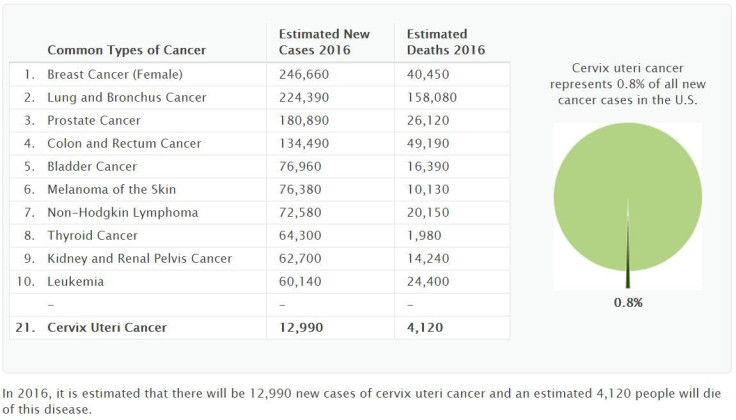Cervical Cancer Update 2017: Symptoms Of The New Subtype Of Female Reproductive Cancer

Doctors may be able to better tailor cervical cancer treatments to different patients with the discovery of a new subtype of the disease.
Although almost all cervical cancers can be traced back to a longlasting infection of human papillomavirus, a study in the journal Oncotarget found that in some tumors containing DNA of that virus, the HPV was actually inactive — the cancers were triggered by HPV, but the virus did not direct the cancer’s progression.
Read: Fighting Ovarian Cancer on Instagram
In those cases, the way the tumor genes expressed themselves was different from cases in which the HPV was active. That could be why they “were associated with poorer survival”: some of those differences in how the tumor genes presented themselves “alter pathways for which targeted therapeutics are available,” meaning they do not have the same vulnerabilities as other cervical cancers. However, the authors also identified genetic mutations in the new cervical cancer subtype that could be targeted instead.
According to the study, in the patients studied, those HPV-inactive cervical cancers accounted for about 8 percent of tumors with virus DNA, and they occurred in older women.
The National Cancer Institute says most cervical cancers affecting the pathway in the female reproductive system called the cervix start in the thin, flat cells that line it. Signs of cervical cancer include abnormal bleeding or discharge, bloating and pressure or pain in the area of the pelvis or back, the U.S. Department of Health & Human Services lists, and the disease can often be cured if detected early. It affects thousands of women in the U.S. every year.
Cervical cancer is just one of several cancers that can be traced back to HPV, a virus that usually goes away on its own and does not cause health problems, the Centers for Disease Control and Prevention says. There are vaccines to prevent HPV from spreading, but it is the most common sexually transmitted disease: “So common that nearly all sexually active men and women get it at some point in their lives.”

The researchers on the new study, from the University of South Carolina, hope their findings will lead to better and more personalized treatment.
“Cervical cancer patients are currently treated as a uniform group based on chemotherapy and radiation regimens that help the largest percentage of people; however, one third of these patients are not helped by standard therapies,” researcher Carolyn Banister said in a statement from the university. “These women may benefit from alternative treatments that are not usually given to cervical cancer patients.”
Banister said doctors should test their cervical cancer patients to see if HPV is active in their tumors.
Source: Banister CE, Buckhaults, PJ, Liu C, Pirisi L and Creek KE. Identification and characterization of HPV-independent cervical cancers. Oncotarget. 2017.
See also:



























